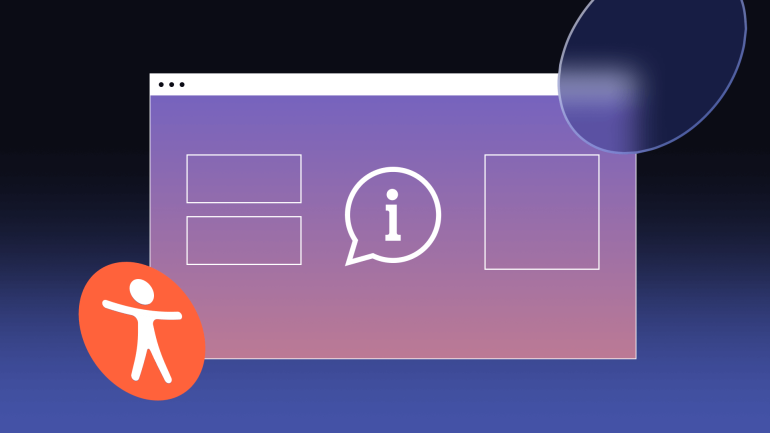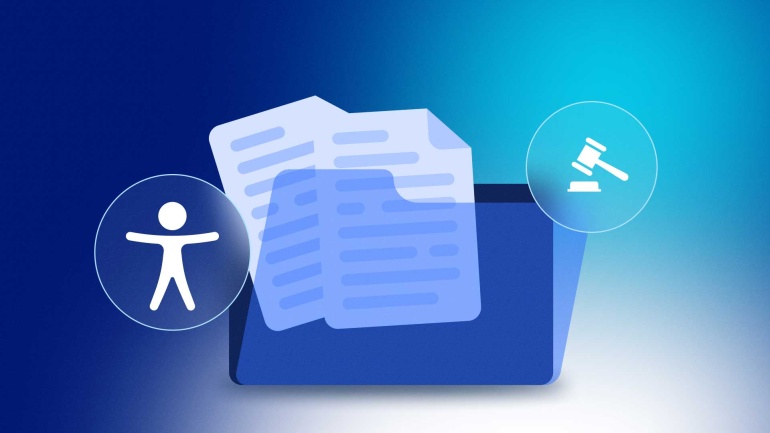Necessity breeds innovation, and necessity has led to the emergence of accessibility overlay software for a more robust and efficient way to provide universal access to digital resources.
Let’s not mince words here: Web accessibility overlays are the future of the Web Content Accessibility Guidelines (WCAG) compliance industry. These simple, downloadable solutions provided by companies like AccessiBe, AudioEye, and UserWay are leveraging AI and machine learning to assist in creating an inclusive digital world faster and more cost-efficiently than ever before. As tech continues to develop, these tools will likely be more thorough and accurate, too.
One in four Americans live with a vision, hearing, motor, or cognitive disability, and throughout the world, a staggering one billion people, or 15% of the world population, are disabled. Despite this fact, only 2% of the world’s one million top websites are accessible for those with disabilities.
There is clearly a disconnect in supply and demand in digital accessibility, and web overlays are helping in filling that gap.
The Importance of Web Accessibility
Accessibility rights in the U.S. are established through Section 508 of the Rehabilitation Act of 1973 and the Americans with Disability Act (ADA) of 1990. Unfortunately, these key pieces of legislation could take into account the paradigm shift of the Dot Com explosion in the mid-90s. Congress amended the Rehabilitation Act in 1998 to require federal agencies to make their digital resources accessible to people with disabilities. However, no changes have been made to the ADA — the law which extends accessibility rights to places of public accommodation, including businesses.
Several factors are driving web accessibility demand to where it is today. For one, the Diversity, Equity, and Inclusion (DEI) movement has become mainstream in the U.S. and progressively dominant in the corporate world. Businesses are also realizing the opportunity costs of web accessibility in terms of competitive advantage — they’re also learning that fumbling web accessibility can turn into costly litigation.
The importance of web accessibility primarily encompasses three points:
- Equal access
- Legal protection
- Competitive advantage
Equal Access
Discrimination based on disability often involves perception, but functionality is equally important. For example, despite how an institution may view people with disabilities if its physical and digital assets prevent these individuals from accessing resources and services, there is discrimination happening.
Legal Protection
A recent report from 2020, estimated that approximately 265,000 web accessibility demand letters were delivered to businesses — a 64% increase in items sent from the previous year. Because of how federal accessibility laws are structured, litigation is the main means of remediation.
Competitive Advantage
A recent study showed the disposable income of people with disabilities to be $1.3 trillion in the U.S. When you factor in friends and family, this share grows to more than $7 trillion. Businesses whose websites are digitally accessible can quickly win space in this market share.
So what’s an overlay? And how can one provide solutions to these needs? Let’s dive in.
What is an Overlay?
The odds that you’ve used a web overlay are high. Some overlay examples include chatbots, call-to-action prompts that trigger after certain mouse movements, promotional pop-up notifications, or tools to navigate the page or share content on social media.
So exactly what is an overlay? They are highly leveraged Javascript-powered site downloads that rest on the “edge” of a website or right on top of the final layer of information being presented for viewing. Being “on the edge” allows page overlays to execute a variety of functions between the site and the end-user.
Gamechangers — Accessibility Overlays
One of the most significant drivers in web accessibility is the emergence and sharpening of AI-powered tech and accessibility overlays, offering the ability to quickly identify potential violations with site updates and conduct thousands of remediations and code adjustments within minutes.
Human remediation has long dominated WCAG compliance, and perhaps for good reason. For one, until recently AI technology has not been sharp enough to compete with human testing and remediation. Requirements, such as those established in the WCAG, are highly technical, and digital accessibility is more than filling out a checklist, it requires meaningful changes.
An overlay has the ability to scan a website code to identify and locate issues and it can even provide insights for developers on how to resolve the issue. When code problems are detected, overlays can make automated corrective actions in order to assure a site is accessible to an end-user. For example, the software can find missing or empty alt-tags and even make suggestions for what that text should say.
Customizable Features
Because of where page overlays rest in a website’s software stack, they allow site guests to customize how content is displayed to them through on-page widget interfaces. When executed properly, this allows overlays to be highly efficient accessibility tools as they enable users to tailor their experience on a website with things like larger text sizes, screen dictation, color contract selection, and animation pause.
Customization is not only an invaluable option for those needing accommodations for a permanent disability, but also for the vast majority of those who experience situational and invisible disabilities every day.
Web Overlays for Better Accessibility
Competition in the traditional web accessibility space has led to a “club mentality” in the industry space among legacy companies and has led to a surge in anti-overlay marketing. Many of their arguments lump all overlay software together with bad apples to strawman the tech. But there are serious problems facing the traditional compliance market, too. For one, enterprise-sized companies now have massive website catalogs with decades’ worth of content that make complete compliance essentially insurmountable by hand.
Strict human remediation and building accessible sites from the ground up mean the barriers of entry for compliance are so high, that most small and medium-sized businesses and ecommerce storefronts likely have no way of reaching compliance.
There is also a common ethical issue in manual remediation. Some developers write code to correct a plugin for one client, then copy and paste it repeatedly for other clients — in some cases at full price.
A Solution for the Modern Website
As they currently stand, web accessibility compliance standards are problematic with the modern website model.
The World Wide Web Consortium’s current WCAG 2.X paradigm literally stipulates that web solutions must be perfect or they are not conformant. However, this is not entirely realistic in light of the way dynamic websites are being built. When the expectation among the accessibility community is to build for accessibility first, this implies that a site’s author is the lone source for content and ignores the fact that many sites are running as many as 30 plugins simultaneously to deliver content. Which one is the source? Who is responsible for the remediation?
Since it is not possible to completely monitor or correct the dynamic content added to a website, remediations through edge technologies like overlays are essential to a modern solution to equal web access.
Affordability
According to a 2022 report, getting accessibility to automated detection, manual review, and user testing with assistive technology can cost at least $10,000 for a basic website. Average sites can cost between $20,000 and $35,000. For large enterprises with large amounts of historical content, this number can reach the six-figure range.
For a service like UsableNet, a company that capitalizes on “inclusive accessibility” and decries the use of widgets and overlays, the average website remediation can cost between $5,000 and $20,000. Other similar companies like Siteimprove and Silktide are quote-based and not upfront with their pricing models.
A strict overlay remediation service, such as AccessiBe, will range in price from $490 per year for sites under 1,000 pages to $1,990 per year for sites under 100,000 pages. A hybrid overlay-based solution, such as UserWay, leverages AI and manual remediation for optimized compliance, and prices can range from $490 per year for a site with 100,000 visitors a month to $3,290 a year for large sites with up to 10 million monthly visitors.
Tips for Picking the Best Overlay-Widget Solution
There are a number of accessibility overlay solutions available on the market. Many promise a streamlined accessibility compliance solution simply by inserting a line of code onto your page. These kinds of promises should be heard with skepticism until they can meet that burden of proof. The reality is that AI corrections are not as capable as hand remediation yet, though they soon could be.
It should be emphasized that overlays should not be viewed as a one-stop solution for accessibility. Humans should not be removed from the remediation process. But rather than perform the tedious and time-consuming tasks of finding and correcting problems by hand, humans should use overlays to make the traditional remediation process more efficient.
Finding an overlay service that leverages both automated corrections and manual review is currently the best way to assure true compliance accuracy as well as cost and time efficiency.



